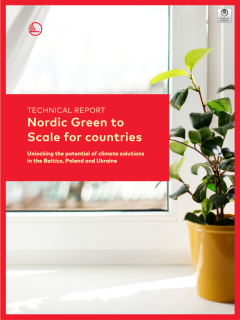
The Green to Scale project highlights potential of scaling up existing climate solutions. In 2015, the project looked at 17 solutions from five different sectors, both from the global North and South. In 2016, it focused on 15 Nordic solutions ranging from wind power to electric vehicles. Nordic Green to Scale 2 (NGtS2) analyses the potential of scaling up existing climate solutions in two regions: the Baltic countries, Poland and Ukraine in Europe; and Kenya and Ethiopia in East Africa.
This report reflects the study results for the five European target countries (Estonia, Latvia, Lithuania, Poland and the Ukraine). Ten different solutions have been selected out of those included in the two previous studies as particularly promising for that region. The analysis covers emission reduction potential, costs and savings as well as cobenefits of scaling up the selected solutions. In addition, the study looks at the country-specific circumstances for implementing the solutions, including providing policy recommendations tailored to the needs of target countries. The abatement potential varies greatly between solutions and countries, as the studied countries are of different size, economic structure and development level.
The study finds that if the solutions are implemented together, the abatement potential will be 149 Mt CO2eq, which forms 13% of the selected region’s GHG emissions by 2030. In absolute values, the highest abatement potential in these countries is related to energy efficiency in buildings and industry (53 Mt CO2eq and 25 Mt CO2eq respectively). By sector, the highest abatement potential is derived from the buildings and household sector: applying energy efficiency measures and using bioenergy for heating (67 Mt CO2eq). The solutions in the energy sector follow, mainly resulting from the abatement potential of onshore wind and solar power development (41 Mt CO2eq).
The solutions with highest abatement potential are also the ones that are very cost-efficient, as their total cost is negative: energy efficiency in buildings would bring net savings of EUR -2.9 billion and energy efficiency in industry would bring net savings of EUR -0.5 billion by 2030. The unit cost for improved energy efficiency in buildings would be EUR -54 per tonne CO2eq and EUR -18 per tonne CO2eq for improved energy efficiency in industry. The highest costs are with bioenergy for heating (EUR 1 billion), onshore wind (EUR 0.5 billion) and solar power (EUR 0.4 billion).
